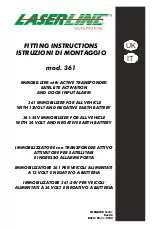
8
ITI/North American Sensor Carbon Monoxide Alarm Installation Instructions
Maintaining the Alarm
and Using the Test/
Reset Function
Maintaining Your CO Alarm
•
Ensure the Alarm Vent is free of dust and debris by vacuuming the vent periodically (see Figure 1).
Using the Test/Reset Function
1.
Set your control panel to SENSOR TEST mode.
Note
If you do not set your panel to sensor test mode while using the Test/Reset function, an alarm signal will be reported to
the central monitoring station. Contact the central monitoring station prior to testing and inform operators not to dis-
patch emergency services.
2.
Unplug the CO alarm for 10 seconds.
3.
Plug in the CO alarm and wait five seconds. Next, press and hold the TEST/RESET button (see Figure 1) for
five to seven seconds; the unit beeps, a red alarm light flashes, and a transmitter inside the CO alarm transmits
a Tamper/Alarm signal that the panel can receive.
4.
Listen for the appropriate beeps (varies by panel) from interior sirens before releasing the TEST/RESET but-
ton.
5.
At the panel, exit the SENSOR TEST mode by entering the disarm command.
If the CO Alarm Continues to Sound After Pressing Test/Reset
If your CO alarm activates within six minutes after pressing the TEST/RESET button, a hazardous level of CO is
being monitored. Refer to the
What if the Alarm Sounds?
section for further instruction.
Figure 1. CO Alarm Features
What do the Lights on the CO Alarm Indicate?
•
Green
— The green light indicates your CO alarm is powered (see Figure 1). It is normal for this light to
remain on while the alarm is connected to an electrical source.
•
Red —
The red light indicates your CO alarm is sounding a full alarm (see Figure 1). It is normal for this light
to remain on while pressing the TEST/RESET button.
Homeowner Safety
Tips
Homeowners can take several steps to avoid exposure to harmful CO levels and ensure their home is safe. By fol-
lowing sensible maintenace and safety procedures in the home, you can stay safe and save on fuel costs:
•
Make sure all fuel-burning equipment vent hoods and exhaust pipes are free and clear of debris.
•
Have your fuel-burning equipment periodically inspected for safety and efficiency by a qualified technician.
•
Inspect the clean-out on your chimney for dirt and debris.
•
Never operate a gas powered engine, kerosene stove, or charcoal grill in a confined space.
•
Never attempt to add a ‘heat reclaimer’ or ‘automatic flue damper’ to your gas furnace or water heater.
Because of risks from installation and/or mechanical failure, gas installation safety codes prohibit the use of
such devices as add-ons to existing furnaces.
•
Vent all gas dryer exhaust ducts to the outside and place a hood at the end of the duct. Inspect the exhaust sys-
tem for lint or debris and make sure the hood flap moves freely.
•
Keep all furnace panels and grills in place and close all fan compartment doors while the furnace is operating.
Technical Information
Your CO alarm uses a sensing technology to vary exposure times prior to alarm activation. Exposure times are
based on monitored CO levels; a full alarm is activated when CO levels reach the following units in parts per mil-
lion (ppm):
•
Less than 90 minutes at exposures of 100 ppm.
•
Less than 35 minutes at exposures of 200 ppm.
•
Less than 15 minutes at exposures of 400 ppm.
8966G05A.DS4
ALARM VENT
TEST/RESET
BUTTON
INDICATO R
LIGHTS
SIREN VENT
This device may not sound an alarm at low CO levels. The Occupational Safety
and Health Administration has established that continuous exposure to levels of
50 ppm should not be exceeded in an 8-hour period. This device has not been
tested for CO at levels below 100 ppm. Upon detecting CO levels of 50 ppm for 30
minutes, the CO alarm sounds a low-level warning -- three continuous beeps
sounded once each minute with a flashing red LED. Indiviuals with a medical
condition and the elderly may consider a more sensitive CO alarm.
Warning
!


























